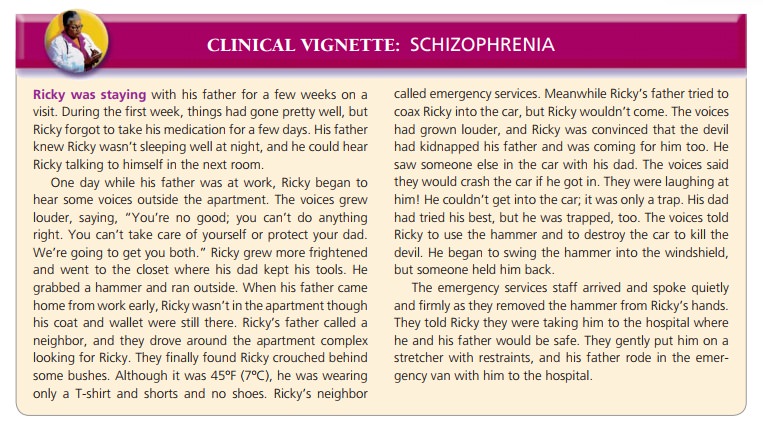Chapter: Psychiatric Mental Health Nursing : Schizophrenia
Schizophrenia
Schizophrenia
SCHIZOPHRENIA CAUSES
DISTORTED and bizarre thoughts, percep-tions, emotions, movements, and
behavior. It cannot be defined as a single illness; rather, schizophrenia is
thought of as a syndrome or as disease process with many different variet-ies
and symptoms, much like the varieties of cancer. For de-cades, the public
vastly misunderstood schizophrenia, fearing it as dangerous and uncontrollable
and causing wild distur-bances and violent outbursts. Many people believed that
those with schizophrenia needed to be locked away from society and
institutionalized. Only recently has the mental health in-dustry come to learn
and educate the community at large that schizophrenia has many different
symptoms and presenta-tions and is an illness that medication can control.
Thanks to the increased effectiveness of newer atypical antipsychotic drugs and
advances in community-based treatment, many cli-ents with schizophrenia live
successfully in the community. Clients whose illness is medically supervised
and whose treat-ment is maintained often continue to live and sometimes work in
the community with family and outside support.
Schizophrenia usually is diagnosed in late adolescence or early
adulthood. Rarely does it manifest in childhood. The peak incidence of onset is
15 to 25 years of age for men and 25 to 35 years of age for women (American
Psy-chiatric Association [APA], 2000). The prevalence of schizophrenia is
estimated at about 1% of the total popula-tion. In the United States, this
translates to nearly 3 mil-lion people who are, have been, or will be affected
by the disease. The incidence and the lifetime prevalence are roughly the same
throughout the world (Buchanan & Carpenter, 2005).
The symptoms of schizophrenia are divided into two major
categories: positive or hard symptoms/signs, which include
delusions, hallucinations, and grossly disorganized thinking, speech, and
behavior; and negative or soft symptoms/signs,
which include flat affect, lack of volition,
and social withdrawal or discomfort. For Diagnostic and Statistical
Manual of Mental Disorders, 4th edition, Text Revision (DSM-IV-TR; APA,
2000) diagnostic criteria for schizophre-nia, please refer to the DSM-IV-TR Diagnostic Criteria.
Medication can control the positive symptoms, but fre-quently the negative
symptoms persist after positive symp-toms have abated. The persistence of these
negative symp-toms over time presents a major barrier to recovery and improved
functioning in the client’s daily life.
The following are the types of schizophrenia according to the DSM-IV-TR (APA, 2000). The diagnosis is
made according to the client’s predominant symptoms:
·
Schizophrenia, paranoid type: characterized by
persecu-tory (feeling victimized or spied on) or grandiose delu-sions,
hallucinations, and, occasionally, excessive religiosity (delusional religious
focus) or hostile and aggressive behavior
·
Schizophrenia, disorganized
type: characterized by grossly
inappropriate or flat affect, incoherence, loose associations, and extremely
disorganized behavior
Schizophrenia, catatonic type: characterized by marked psychomotor disturbance, either
motionless or exces-sive motor activity. Motor immobility may be manifested by
catalepsy (waxy flexibility) or
stupor. Excessive motor activity is apparently purposeless and is not
influenced by external stimuli. Other features include extreme negativism,
mutism, peculiarities of voluntary movement, echolalia, and echopraxia.
·
Schizophrenia,
undifferentiated type: characterized by mixed
schizophrenic symptoms (of other types) along with disturbances of thought,
affect, and behavior
·
Schizophrenia, residual type: characterized by at least one previous, though not a current,
episode; social withdrawal; flat affect; and looseness of associations
Schizoaffective disorder is diagnosed when the client
has the psychotic symptoms of
schizophrenia and meets the criteria for a major affective or mood disorder.
The mood disorder can be mania, depression, or mixed moods. There is
disagreement among psychiatrists about the validity of this diagnosis, with
many believing that a diagnosis of psy-chotic mood disorder is more appropriate
(Lake & Hurwitz, 2007). Other clinicians believe it would be more
beneficial to diagnose the client with schizophrenia and a mood disorder, such
as bipolar disorder (Mahli, Green, Fagiolini, Peselow, & Kumari, 2008),
rather than try to combine the two diagnoses.

Related Topics